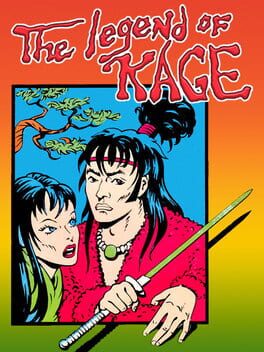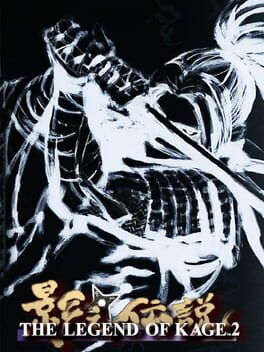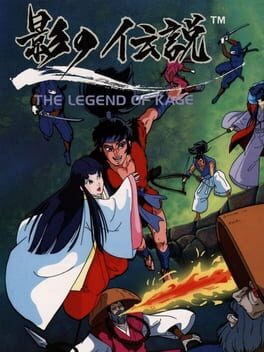

A port of The Legend of Kage
The Legend of Kage is a port of the 1985 arcade game under the same name. The player is armed with a kodachi shortsword and an unlimited amount of shuriken. Grabbing a crystal ball causes the player character's Kage's clothes to change to the next level in colour and thereby attain certain powers (bigger shuriken and/or faster speed); if Kage is hit while in green or orange clothes, he does not die but revert to his normal red clothes. Grabbing a scroll causes Kage to stand still and meditate for several seconds while approaching enemies drop to the ground dead.
Also in series
Released on
Genres
Reviews View More
I wasted many hours on this game.
It’s simple. And hard.
Ur I played it so much that I ended up able to beat it over and over without losing a life.
See, this game is old school arcade stuff. Once you beat the last boss, the game starts over, but the difficulty is ramped up. It’s a never ending cycle.
Highest I’ve gone is ten repetitions.
I don’t know if it gets harder after every restart or not. I know some games of that type only do it with the first rep.
To me, this game is excellent. The sound of clashing abs ringing swords is actually pretty well done for a NES game. Obviously not accurate, but nice all the same.
The music is decent. Freedom of movement is unusual for a NES game if it’s age.
Might actually be too much freedom lol you can over shoot where you wanted to go.
Or accidentally jump too high right into enemy projectiles.
In the end, I found it rewarding just to know I did something like this. Even if it was the height of dumb lmao
It’s simple. And hard.
Ur I played it so much that I ended up able to beat it over and over without losing a life.
See, this game is old school arcade stuff. Once you beat the last boss, the game starts over, but the difficulty is ramped up. It’s a never ending cycle.
Highest I’ve gone is ten repetitions.
I don’t know if it gets harder after every restart or not. I know some games of that type only do it with the first rep.
To me, this game is excellent. The sound of clashing abs ringing swords is actually pretty well done for a NES game. Obviously not accurate, but nice all the same.
The music is decent. Freedom of movement is unusual for a NES game if it’s age.
Might actually be too much freedom lol you can over shoot where you wanted to go.
Or accidentally jump too high right into enemy projectiles.
In the end, I found it rewarding just to know I did something like this. Even if it was the height of dumb lmao
A year after the release of Ninja Hayate, Taito published Kage no Densetsu (1995) on arcade machines. The gameplay is quite different with the former being an interactive film – not unlike Dragon's Lair (1983), the inspiration is crystal clear –, while The Legend of Kage appears to be a very classic action platformer. The ambitions are certainly not very high for this title, which is confirmed by the length of a game: about twenty minutes, at most. You play as Kage, a shinobu in a fictitious, misidentified Japan: his goal is to free Princess Kiri, captured by a renegade samurai, Yoshirou Yukigusa. The manual for the NES version suggests that the action takes place at the end of the Edo period, but it's hard to see this kind of plot fitting into the bakumatsu timeline. Instead, the game seems to draw on Japan's feudal folklore. This is a general trait of Japanese fiction towards shinobu and samurai stories, which it perceives with a certain poetic licence.
Moreover, The Legend of Kage is a very formal title: it consists of five repeating levels, each with its own particular objective. You have to get rid of a monk in the forest, before infiltrating a castle. This requires killing a certain number of enemies or simply reaching the end of the level. The game attempts to play on verticality, capitalising on Kage's jumping height, but the execution leaves a bit to be desired, as air control is almost non-existent. Most of the action is thereby about preemptively getting rid of opponents with our shurikens, unlimited in their number. It is possible to parry adverse attacks – except fireballs – with our own blade, but its exetremely short range requires sharp reflexes. The gameplay loop is particularly short, which prevents the player from feeling the slightest fatigue. As soon as one level is completed, environment changes. When you save the princess, the game loops from the forest, and all the colours change to mimic the passage of the seasons, from summer to autumn and then winter. This is not an unusual touch in games from the 1980s, but it is still a welcome addition for the sake of visual diversity. As such, the game is rather charming and, albeit simplistic, an effective representation of the fantasy of medieval Japan.
It's hard to say much more than that, as the title is in the underbelly of the productions of this era. The gameplay never shows a real spark of genius, but is decently implemented. In some respects, it's a shame that The Legend of Kage isn't a bit more similar to Ninja Hayate, which offered more creative and comical scenes. Thus, Kage no Densetsu acts as a neglected little brother, without ever being bad.
Moreover, The Legend of Kage is a very formal title: it consists of five repeating levels, each with its own particular objective. You have to get rid of a monk in the forest, before infiltrating a castle. This requires killing a certain number of enemies or simply reaching the end of the level. The game attempts to play on verticality, capitalising on Kage's jumping height, but the execution leaves a bit to be desired, as air control is almost non-existent. Most of the action is thereby about preemptively getting rid of opponents with our shurikens, unlimited in their number. It is possible to parry adverse attacks – except fireballs – with our own blade, but its exetremely short range requires sharp reflexes. The gameplay loop is particularly short, which prevents the player from feeling the slightest fatigue. As soon as one level is completed, environment changes. When you save the princess, the game loops from the forest, and all the colours change to mimic the passage of the seasons, from summer to autumn and then winter. This is not an unusual touch in games from the 1980s, but it is still a welcome addition for the sake of visual diversity. As such, the game is rather charming and, albeit simplistic, an effective representation of the fantasy of medieval Japan.
It's hard to say much more than that, as the title is in the underbelly of the productions of this era. The gameplay never shows a real spark of genius, but is decently implemented. In some respects, it's a shame that The Legend of Kage isn't a bit more similar to Ninja Hayate, which offered more creative and comical scenes. Thus, Kage no Densetsu acts as a neglected little brother, without ever being bad.


